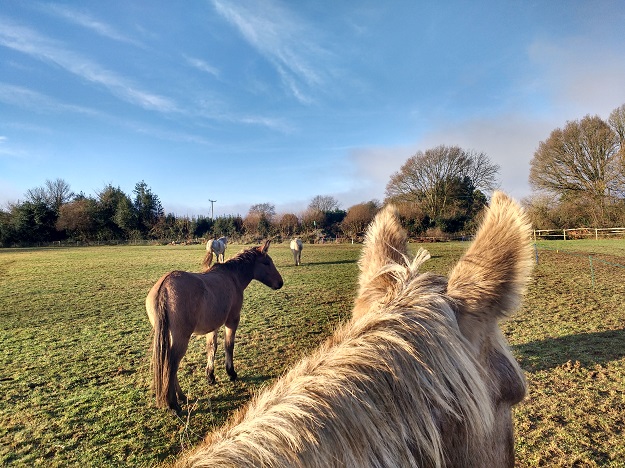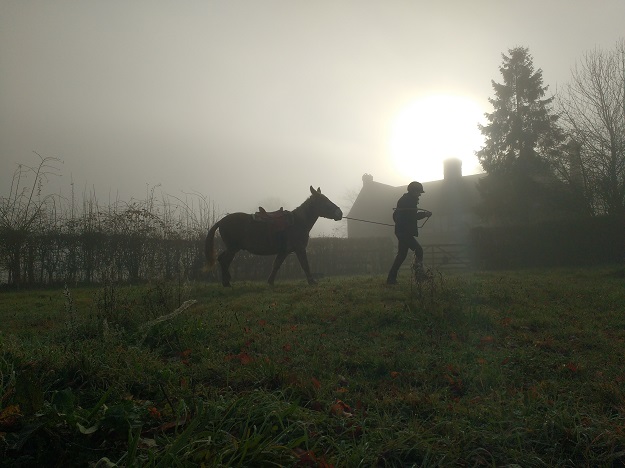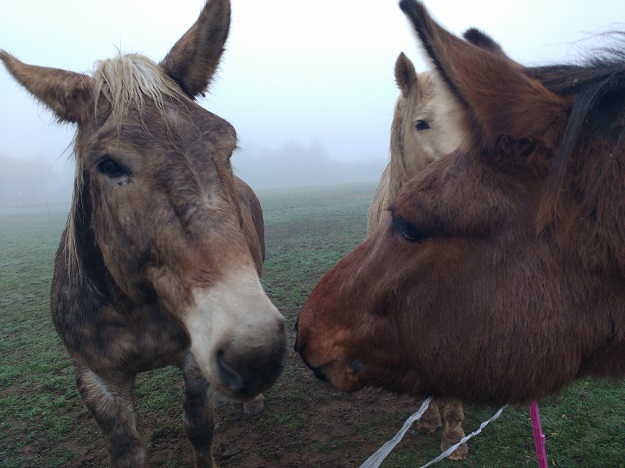One of the things that Xato has given me cause to think about is that, just as there is no single formula for training a horse/mule (you work with the horse you have in front of you, as the saying goes), the handler/rider’s capabilities should be taken into account too.
For example, something we’ve been working on lately is asking Xato not to drag behind if his handler speeds up. He’s a fairly sedate kind of guy and doesn’t see why he should have to hurry anywhere. Personally, I agree with him, but there are going to be times when I will need him to haul ass. I know teaching Marty how to trot in hand has been very useful – if the dentist or our trimmer is visiting and I have to swap equines around, it saves time if I can sprint up to the field and back!


On Saturday we had a very long session that involved a lot of this work. Ben did the majority of handling as I’d asked him to ride Xato for me, but – as often happens – some other things cropped up that needed addressing first.
Ben’s method was just to strike off at the pace he wanted to set, and if Xato hung back, then Ben would maintain the tension in the rope until Xato released the pressure himself. Soon we were getting some lovely work where Xato could speed up, slow down, back up, come forward, and even trot to catch up – all without leaning on the rope. I had a go and was thrilled at the difference. It felt like leading a cloud.


The next day we’d planned to ride, but practiced our leading first. Initially he felt good, but then he began to drag again so I set off like I’d seen Ben do. I walked two sides of the paddock before he finally decided to make life easier for himself and walk a little faster, and by that time I was knackered and feeling pretty sore.
I complained to Ben, saying how much I hated doing this: it pulled on my wonky back and put pressure on my ribcage, helpfully compressed for me by a Shire horse a decade or so ago.
“Alright,” said Ben, “so don’t pull on him.”
“But I have to,” I replied, confused. “I was just trying to do what I saw you do. How can I use your method and persuade him to catch up without pulling?”
“When the rope gets straight,” said Ben, “that’s because he’s missed the signal. The pull is plan B to say ‘You should have listened to the signal’, as is the swinging of the rope to back it up. With you, if he creates that pull you will still need to maintain the tension, but you can stay on the edge of it and use your rope to back it up sooner. So long as you get your timing right he will still learn the same thing. Shall I walk with you while you do it and talk you through it?”
This method was a lot easier on my chest and back. I’m not averse to hard work, but if I physically can’t maintain something then it’s likely to do more harm than good to both of us.


Another place where this need to adapt came up is in Xato’s steering. Although I have a bit for him, I have only been riding him in the same thing I do his groundwork in – his Dually headcollar. He is not very keen on bending and at first this made leading him a bit of a wrestling match sometimes, but we worked hard on installing a disengage and he’s come through really nicely (most of the time! There is still work to be done before I want to ride him outside of a contained area).
I complained to Ben (again – it’s what I do, poor guy) that when I was on Xato’s back and he got an idea to go somewhere, I really struggled to turn him; whereas it was easier on the ground, because if he didn’t respond to my cue then I could turn him by putting my whole body weight into it.
“Aha,” said Ben. “There’s the problem. You shouldn’t need to be relying on strength at all.”
And he taught me to bump on the rein (or the leadrope) rather than just setting myself up for a tug-of-war. Brute strength is never going to get anywhere with Xato; I need to learn to direct his mind if we’re ever going to get our ridden work successful.


This post started some interesting discussions over on Facebook, which you can hopefully read in the comments here:

Love Xato….. he is soooooo goodlooking waw….😍